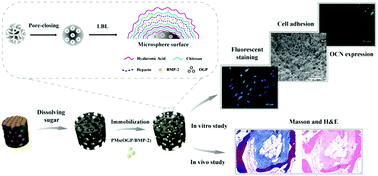Enhanced osteogenesis of multilayered pore-closed microsphere-immobilized hydroxyapatite scaffold via sequential delivery of osteogenic growth peptide and BMP-2†
Abstract
Since many complex physiological processes are controlled by multiple biomolecules, comprehensive regulation of bone tissue regeneration may be more effectively achieved by administering more than one type of biofactor. Thus, we propose a novel bone tissue engineering scaffold incorporating a multiple peptide-based drug delivery vehicle for accelerated bone regeneration. Pore-closed poly(lactic-co-glycolic acid) (PLGA) microspheres with a surface structure of multilayer polyelectrolytes ((Ha-Cs)2-Hep-BMP-2-Hep-(Cs-Ha)2) were prepared as multi-barrier microcarriers for osteogenic growth peptide (OGP). In addition, BMP-2 loading was achieved via a pore-closing process and layer-by-layer (LbL) assembly technique, followed by immobilization on the surface of a highly interconnected porous hydroxyapatite (HA) scaffold. On the basis of such a construction, sequential delivery of OGP and BMP-2 occurred in a coordinated manner through an orchestrated sequence of spatial changes, targeting different bone healing stages. The in vitro studies showed that OGP release was minimal (<11.7%) in the first 15 d but accelerated remarkably thereafter, while at least 56.3% of BMP-2 payload was released at this time and subsequent release was only marginal. In addition, scaffolds carrying dual-biofactor exhibited a stronger ability to induce bone marrow mesenchymal stem cell (BMSC) differentiation toward osteoblasts than those incorporating OGP or BMP-2 alone and factor-free scaffolds in terms of alkaline phosphatase (ALP) activity and osteogenic gene and protein (Runx2, COL I, and OCN) expression. The results of in vitro cell culturing demonstrated the roles of BMP-2 in osteogenic differentiation early as well as the effect of OGP on accelerated proliferation and maturation of osteoblast precursors at a later stage. Further in vivo osteogenesis studies also revealed that the dual biofactor-loaded scaffold manifested the best repair efficacy due to a potential synergistic effect of BMP-2 and OGP. Collectively, our findings suggested that such a dual delivery system may provide a therapeutic strategy sequentially targeting multiple events or mechanisms during bone healing and was proved to be a promising therapeutic scaffold for future use in bone tissue regeneration.



 Please wait while we load your content...
Please wait while we load your content...